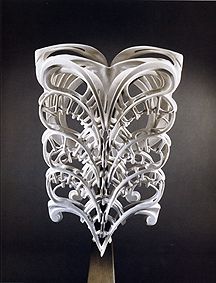When I was thinking about what to say about Ann Hamilton, I heard a discussion on the radio by arts professionals trying to guide a general audience as to how they can appreciate contemporary art. The speakers confirmed that reading about art, looking at as much art as possible, and keeping an open mind, are helpful in appreciating what we see. They also recommended reading about the artists specifically to understand their intentions. It was when the professionals started talking about the difficulties many people have appreciating performance art that I started thinking about how the idea of art has expanded so dramatically in the last, say 50 years. And I don't think the other arts, performing or literary, have taken such diverse paths as have visual arts.
You can still go into a museum or gallery and expect to see paintings on the wall and sculptures on the floor, or wall. And there are prints and drawings and photographs. These aspects of visual art continue. as do public art installations outside the museum context. But, and Tom and I often disagree about this, artists can conceive projects which have no physical components, no objects, just an idea or an action. Many of them use found objects, but also found or created sounds, words, their own bodies, actions as art. To some extent I think some artists struggle to see how far removed their creations can be from the standard media of visual art. Artist do performances; actors do not display paintings on stage. Marina Abramovic sat in a chair at the Museum of Modern Art in New York and faced visitors who chose to sit opposite her. It's unlikely that this would happen in a theater and it would not have the same impact in the context of theater. Sophie Calle asked distinguished women to respond to her boyfriend's breakup email ("Take care of yourself") in the French Pavilion of the 2006 Venice Biennale. It might have been a book, but had to be an art installation (that kept the female audience, myself included, engrossed for hours while their male companions [mine too] waited outside).
Artists do video and film and also use video and film in installations (Nam Jun Paik for example) but videographers and film makers don't replace their works with objects. You still go to the theater and usually sit and watch a play, a movie, or a music performance. But going to a museum can also involve listening to musical sounds, as at the Ann Hamilton show, reading texts, seeing documentation about Tehching Tsieh, who spent a year living in a cage as a work of art, or seeing a preserved shark in a tank of formaldehyde (or its replacement). Writers may use the internet to communicate and they may write with computers rather than a quill pen, but words are still their tools. Artists also use words, as Ann Hamilton does in many parts of her Pulitzer installation, as On Kawara has with his date paintings or as Jenny Holzer does, often using LED displays. The opportunities for visual artists to expand their media and their conceptualization of what they do seem to be limitless, while those who work in the other arts seem primarily to have remained committed to their original discipline, media and basic materials.
That the possibilities are so open for visual artists is a wonderful, exciting thing to think about. But it also makes it quite difficult for anyone - including specialists - to evaluate or understand their work, to have the patience to give it adequate attention, to suspend disbelief long enough to give it a chance to reverberate with their experience and expectations, and to question intelligently whether what the artist is doing has any real worth beyond being different. It will take decades. In the meantime visual artists continue to explore an unprecedented variety of media and methods.

